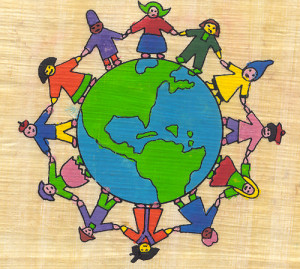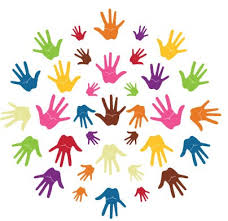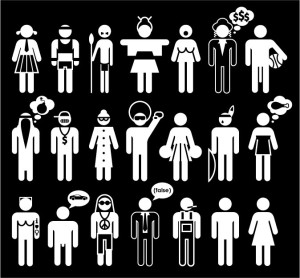Sometimes people are shocked by behaviour they feel shows a lack of “common sense”. Clearly, something that makes sense to members of one culture may make no sense at all to members of another. Sometimes seems incredibly naïve to speak of acceptance, tolerance and empathy in a world that seems increasingly marked by a return to radical tribalism and various aggressive fundamentalisms which claim to have the moral and spiritual high road. It does not mean that people have to relinquish their moral code or consider that all morality is relative. It means that there is more than one path toknowledge and truth, and that people who feel they have found the one good way are frightening, no matter which way they have found. It is our hope that inter-cultural sensitivity can further understanding, by allowing people to move past some of the “annoying” behaviour and “exotic” customs of members of other cultures. We human beings often fear and dislike the unknown. Training in inter-cultural awareness can make the unknown seem a little less surprising.
Terminology: cross- or inter-?
In French the only possible adjective for this field is “interculturel”, whereas in English use both “inter-cultural” and “cross-cultural”. Many English speakers favour “cross- cultural”, some almost avoiding “inter-cultural” as if it were a case of vocabulary interference with French. Others use the terms interchangeably.
“Cross-cultural” applies to something which covers more than one culture. For example “a cross-cultural study of education in Western Europe” would be a comparison of chosen aspects of education in various countries or regions, but would consider each country or region separately and would not suggest any interaction between the various educational systems.
On the other hand, the term “inter-cultural” implies interaction. From an inter-cultural perspective, it would be possible to study the experiences of students or teachers who move from one educational system to another, or to examine the interactions of students from different countries enrolled in a specific class or program. “Culture shock” and “cultural adaptation” are thus inter-cultural notions.
Multicultural:
In multicultural communities, we live alongside one another. We value tolerance, and celebrate one another’s culturally distinctive cuisine, dress, music, dance, and related outward expressions of culture. It usually requires only superficial and polite social interaction. A multicultural community can also mean that
• society allows and includes very distinct cultural groups, with equal status
• people from different cultural groups are understood as standing side-by-side, at times in isolation from one another
• often there is a superficial celebration of food, folk, and festivals without deep learning
• power differentials are not addressed; it does not allow for exchange between these cultural groups, and tends to only focus on representation.
In cross-cultural communities, there is some reaching across boundaries.We try to build bridges of relationship between our cultural communities by sharing, listening, learning, and being open to changing. It usually requires intentionality, and programs of education and community-building. It also means that
• two or more cultures are considered or related to
• often cultures are compared or contrasted with one another, and one culture is deemed superior or inferior to another
• power differentials are still not addressed; it only allows for limited learning or exchange between cultural groups
• cultural differences may be understood or acknowledged, but are also managed in a way that does not allow for individual or collective transformation
Inter-cultural:
In inter-cultural communities, there is comprehensive mutuality, reciprocity, and equality. Our social structures and everyday interactions are defined by justice, mutuality, respect, equality, understanding, acceptance, freedom, diversity, peace-making, and celebration. Inter-cultural community hopes to take us deeper than multicultural or cross-cultural models of community. It also means that
• there are mutually reciprocal relationships among and between cultures
• people from different cultural groups interact with one another, learn and grow together; build relationships and become transformed, shaped, and moulded from each other’s experiences
• “inter-cultural” is not a substitute for “ethnic”!
• the focus is on relationship building (not survival), deep connections, interactions, mutual gifting, respect, and learning from one another
• no one is left unchanged in the inter-cultural process: some examine their own culture more deeply, some are changed through their interaction with others, many learn more about what it means to be in community together
• racial and cultural power imbalances are addressed; people are enabled to learn from each other and lead toward the transformation of all peoples
The word “culture” has many definitions, so it seems important to rule out those that are not pertinent in the context of inter-cultural communication. For example, Latin scholars might emphasize the agricultural roots of the term, which are still apparent in French (e.g. “la culture du maïs”); in English we still speak of a culture of cells in a Petri dish. Nevertheless the definition of culture that is uppermost in many people’s minds is that of “high culture”, as in “the man ain’t got no culture”. Likewise we speak of someone as “cultured” or “cultivated”, or of the “cultural” events scheduled in a certain town on a given weekend. None of these definitions apply in the field of inter-cultural research, which defines culture from a more anthropological perspective.
Milton Bennett, an American inter-culturalist gives this definition: “Culture is the learned and shared values, beliefs and behaviours of a group of interacting people”.
It is crucial to remember that culture is learned, not something “in one’s blood”. Children adopted as infants will have the culture of their adoptive parents and their society, although we can’t totally discount the impact of their very first experiences, even those in the womb (for example, the sound of their birth mother’s voice!). And of course an Asian child adopted by non-Asian parents in Europe, to take one example, will have to “explain” and deal with the difference between his true culture (say, German or French) and the culture that outsiders may expect him to have, based on his appearance.
Thus culture is learned through interaction, and shared by the people interacting. In this definition there is the suggestion of an ongoing process, of culture as a group creation rather than a solidified object. Definitions that compare culture to an iceberg or to an onion are somewhat misleading, despite their obvious pedagogical appeal.
With this inter-cultural definition, it becomes clear that all human beings “have culture”, no matter what their level of formal education. Primatologists have even discovered that groups of chimpanzees share rudimentary culture, developing and then teaching each other specific methods of gathering food and grooming in different geographical areas. This differs from the purely instinctive behaviour shown by other animals.
With this inter-cultural definition, it becomes clear that all human beings “have culture”, no matter what their level of formal education. Primatologists have even discovered that groups of chimpanzees share rudimentary culture, developing and then teaching each other specific methods of gathering food and grooming in different geographical areas. This differs from the purely instinctive behaviour shown by other animals.
Therefore, it will easily concur that a person can be fully a member of his culture even if he or she is illiterate. Likewise to have “French culture” you don’t need to be an expert in French literature, art, music or architecture; you may have only the vaguest notions of any of these things. Bennett uses the term “big C Culture” for the above aspects of culture, and “little c culture” for aspects of behaviour that are learned more implicitly. Edward T. Hall, in his seminal work The Silent Language, says that culture is “out of awareness”, which is precisely why we tend not to realize that we “have”, or belong to, a culture. We have picked up certain beliefs and behaviours through every succeeding moment of our existence, and not necessarily because our parents or other people have explicitly told us “Do this” or “Don’t do that”.
Inter-culturalists are often wary of lists of “Dos and Don’ts” devised for people who are planning to travel or work in foreign cultures. Most of the trivia they include is funny, fascinating or surprising, for example the warning about which way to hold your hand in Britain when you order “two beers”, to avoid insulting the bartender with a vulgar gesture. Or the fact that you should not show the sole of your shoe in an Arab country. Or that French students should not necessarily rush to kiss their English-speaking hosts on both cheeks at the airport. But it is a bit like learning what the traffic signs mean in a foreign country: vital but superficial. Unfortunately it also fosters the idea that foreigners have all sorts of odd, amusing customs that we can learn about. People tend to forget that they, too, have habits that might seem odd and amusing to an outside observer.
Major areas of difference:
Due to the fact that people are unaware of having learned their cultural behaviour, they tend to assume that their group’s way of thinking or acting is human nature. Hence their shock or anger when other people behave in ways they interpret as illogical, unreasonable, or impolite. Before jumping to this conclusion, and placing the conflict or misunderstanding on an interpersonal level, it is often helpful to look at the situation from an inter-cultural point of view.
Most people are not aware of how much their culture shapes their attitudes towards time, space, and interpersonal communication, to name three major areas of difference.
Concerning time: How do people conceptualize it, and what importance is given to the past, the present, and the future? (Cultures do not necessarily see these as existing along a timeline.) What is the organization of the year, and the day? What does it mean to be “on time” in different situations?
If you ask people what time they would expect to arrive in order to be “on time” for a 10 o’clock meeting at work, for a class, dinner at a friend’s house and so forth, they consider it from an inter-cultural perspective. We should not be teaching Germans and Americans that “the French are never on time”, for example, but rather exploring what it means to be “on time” in different situations in France, and when “lateness” (by German or American standards) should not be perceived as insulting but merely as culturally-linked behaviour. Clearly if you are doing business with people from another culture, you might want to find out what time they really expect you to arrive at the meeting, in order to avoid offence on all sides.
Concerning space: How is it divided up and shared? What are the notions of territoriality, of public and private space? How do individuals define their personal space? In any culture the distance we stand from another person varies depending on our relationship to them and the place where we find ourselves, but these norms vary from culture to culture. Things become complicated when people from different cultures interact.
People naturally try to establish the speaking distance that they were brought up to feel comfortable with. That means that in an inter-cultural situation one person might want to stand closer than the other, and will move in, whereupon the other person will pull back. The first person might perceive the other as cold or “standoffish” (note the term), whereas the second person will probably think his interlocutor is pushy or “in his face”.
Concerning body language: What is communicated through posture, movement, gestures and facial expressions, eye contact? Many of my us seem to think that only people from certain cultures “use” body language, for example the Italians. We usually don’t realize that our own bodies are communicating information at any given moment, even if we are not aware of it.
Interpreting people’s body language is an important skill and can even be a defence mechanism. Once again, however, difficulties may arise when we “decode” the body language of people from other cultures as if they were members of our own culture.
Concerning conversation: What is the pattern of turn-taking, in other words how much overlap is there between speakers? What rituals are expected? What topics are avoided? How much information is transmitted explicitly, and how much is suggested indirectly?
In France the skill of social discourse is so prized that when there is a sudden lapse in the exchange, followed by a silence, some people say “un ange passe”, that is “an angel passes/ is passing”. Raymonde Carroll describes conversation in France as a sort of group endeavour. Her book comparing French and American (US) culture is called “Evidences invisibles”, translated as “Cultural Misunderstandings”. The French title is a lovely description of culture: something obvious and yet invisible, obvious to those who share it and often invisible to those “outside”.
Just as most human beings speak more than one language, many of us “share” more than one culture with different groups of people we interact with. When applied to a society, the term “multicultural” can suggest a “mixed salad” and does not necessarily mean that each individual belongs to many different cultures. On the other hand “multicultural” and “bi-cultural”, when applied to an individual, suggest mixing or multiplicity, the ability to function in at least two different groups.
This can happen in many ways, and may even apply to most people in border regions where two groups interact frequently. It can be the case of immigrants or anyone who lives with members of another culture and assimilates aspects of their behaviour. Other individuals become bi-cultural through interaction with a mother and father from different cultures, or with grandparents, step parents, or caregivers. Yet another group, sometimes called “third culture kids”, has lived briefly in many different cultures, usually due to their parents’ professions, often military, diplomatic or business-related.
Many people believe in the dubious notion of a “perfect bilingual” with a native command of two languages and no influence of one language on the other. Few people would expect this lack of influence in the case of two co-existing cultures. Bi-cultural individuals have necessarily lost the innocent and dangerous belief that there is only one way of doing things or of looking at a problem. They sometimes feel they have the best of both worlds, and sometimes that they are not truly at home in either culture. Frequently they move back and forth on a continuum between these two feelings.
As a young man in one of his classes in France said, “Here I am Chinese, but when I go back to Taiwan I am the Frenchy.” This comment emphasizes how the perception of personal culture is constantly changing, subject to people’s image of themselves, influenced by the feedback they receive from others. This is part of the construct of identity, which also includes other characteristics such as age, sex, and profession.
One of the most frequent criticisms made about inter-cultural awareness training or about any discussion of “cultural differences”, is that they encourage the propagation of stereotypes concerning people from other cultures. Since stereotypes are by definition oversimplified and by nature judgemental and often derogatory, this would certainly not encourage effective inter-cultural communication.
There are those who maintain that if enough people in a culture share a stereotype about another group, then this stereotype must have a “kernel of truth”. This is said to be especially true when people from different cultures share a common stereotype about a certain cultural group. Yet on the other hand we are all familiar with the idea that a lie, if repeated often enough, will ultimately gain credence with some of the people who hear it. I think it is important to underline that stereotypes say something not only about the people being judged, but also about those doing the judging and their vision of themselves.
Personal or idiosyncratic stereotypes are easy to form through personal contacts, but relatively easy to counter on the basis of logic. Shared stereotypes can be hardier, insofar as they play into the “us vs. them” mentality. They can provide a fairly harmless outlet for the frustrations of the “out” group, for example in the case of host-culture bashing on the part of foreigners living there, but can also provide dangerous scapegoats for large, angry groups of people.
Whenever the subject comes up in whatever places, it is important to remind ourselves of the limits of generalization and the importance of the words used. Stereotyping lumps all members of a group or culture together, whereas generalization allows room for variation. It encourages people to approach an individual with certain expectations, but to be willing to modify these expectations if the individual seems not to fit the expected “norm”. In addition, stereotyping often uses words that are derogatory and emotionally charged, whereas the same information could be expressed in a more neutral, less aggressive way. Does this sound like proselytizing or political correctness?

Sources:
1) Cultural, Multicultural, Cross-cultural, Intercultural: A Moderator’s Proposal by: Susan Fries, TESOL-France http://www.tesol-france.org/
2) Defining Multicultural, Cross-cultural, and Intercultural, © 2011 The United Church of Canada





